Bristol Airport
Bristol Airport (IATA: BRS, ICAO: EGGD), at Lulsgate Bottom in North Somerset, is the commercial airport serving the city of Bristol, England, and the surrounding area. It is 7 nautical miles (13 km; 8.1 mi) southwest of Bristol city centre.[1] Built on the site of a former RAF airfield, it opened in 1957 as Bristol (Lulsgate) Airport,[3] replacing Bristol (Whitchurch) Airport as Bristol's municipal airport. From 1997 to 2010, it was known as Bristol International Airport.[4] In 1997, a majority shareholding in the airport was sold to FirstGroup, and then in 2001 the airport was sold to a joint venture of Macquarie Bank and others. In September 2014, Ontario Teachers' Pension Plan bought out Macquarie to become the sole owner.
Bristol Airport | |||||||||||
|---|---|---|---|---|---|---|---|---|---|---|---|
 | |||||||||||
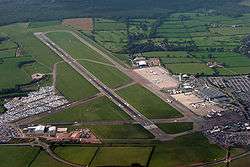 | |||||||||||
| Summary | |||||||||||
| Airport type | Public | ||||||||||
| Owner | Ontario Teachers' Pension Plan | ||||||||||
| Serves | Bristol, Gloucestershire, Herefordshire, Somerset, North & West Wiltshire | ||||||||||
| Location | Lulsgate Bottom North Somerset | ||||||||||
| Focus city for | |||||||||||
| Elevation AMSL | 622 ft / 190 m | ||||||||||
| Coordinates | 51°22′58″N 002°43′09″W | ||||||||||
| Website | www | ||||||||||
| Map | |||||||||||
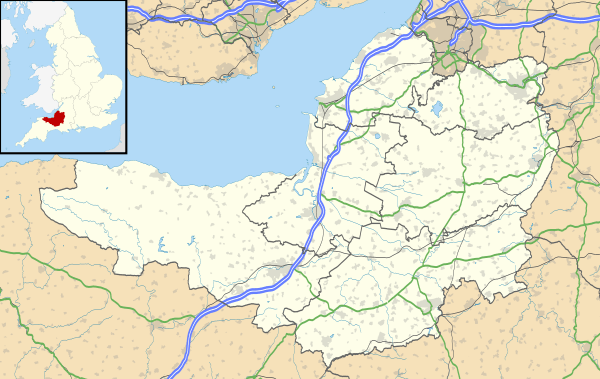 EGGD Location in Somerset | |||||||||||
| Runways | |||||||||||
| |||||||||||
| Statistics (2018) | |||||||||||
| |||||||||||
In 2018, it was ranked the ninth busiest airport in the United Kingdom, handling nearly 8.7 million passengers, a 5% increase compared with 2017.[2] A passenger survey carried out in 2015 found that 32.5% of journeys using the airport started or ended in the city of Bristol, 9.6% in Gloucestershire, 24.5% in Somerset and 16.9% in Devon.[5]
Airlines with operating bases at the airport include EasyJet and Ryanair. The airport has a Civil Aviation Authority Public Use Aerodrome Licence (number P432) that allows flights for the public transport of passengers and for flying instruction.
History
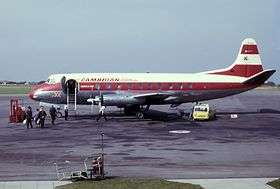


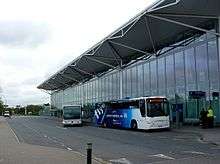
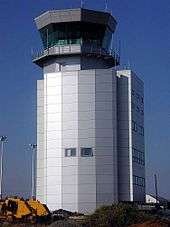
First airport
In 1927, a group of local businessmen raised £6,000 through public subscription to start the Bristol and Wessex Aeroplane Club,[6] a flying club initially based at Filton Aerodrome. In 1929, Bristol Corporation took up the club's proposal to develop farmland located at Whitchurch, to the south of Bristol, into a municipal airport.[7] On its opening by Prince George, Duke of Kent in 1930, Bristol (Whitchurch) Airport was the third civil airport in the United Kingdom. Passenger numbers grew to 4,000 by 1939.[6]
During World War II, Whitchurch was the main civil airport remaining operational. The newly formed British Overseas Airways Corporation (BOAC) was transferred to Whitchurch from Croydon Airport and Heston Airport.[8] BOAC operated routes around the British Empire and to neutral nations, including the Bristol–Lisbon route which was operated by the Dutch airline KLM, under charter to BOAC.[9]
RAF Lulsgate Bottom
In September 1940, No 10 Elementary Flying Training School at RAF Weston-super-Mare established a Relief Landing Ground on 14 acres (5.7 ha) at Broadfield Down by the hamlet of Lulsgate Bottom, southwest of the city and north of Redhill village. Being high, at 600 ft (180 m), the site had a poor weather record during warm front conditions, when it was often covered in low cloud.[10] However, when this occurred the alternative airfields at Filton and Cardiff were usually clear and operational; and as Lulsgate was clear when the low-lying airfields were obscured by radiation fog in calm weather, the landing ground provided a useful alternative. Few facilities were constructed although pillboxes, defensive anti-aircraft guns and later two Blister hangars were added.[10] In late 1940, a Starfish site was set up[11] south of the village of Downside and just west of the airfield.[12] Its decoy fires attracted a large quantity of Luftwaffe high explosives and incendiaries on the nights of 16 March, 3 April and 4 April 1941 during the Bristol Blitz.[13]
In 1941, RAF Fighter Command planned to use the airfield for an experimental unit, and after requisitioning land from several adjacent farms, contracted George Wimpey and Company to begin work on 11 June 1941.[10] However, its intended use soon changed into being a satellite airfield for the fighter squadrons based at RAF Colerne. Originally, the new airfield's name was to be RAF Broadfield Down.[14] The runways used the standard triangular pattern. The main, east-west runway was 3,891 ft (1,186 m) long, with a designated alignment of 28/10, and the others were 3,300 ft (1,000 m) aligned 21/03 and 3,294 ft (1,004 m) aligned 34/16.[12] The first aircraft to land was a Luftwaffe Ju 88 at 06.20 on 24 July 1941. Returning from a raid, its crew had been deceived by the RAF electronic countermeasures radio beacon at Lympsham, which was re-radiating the signal from a Luftwaffe homing beacon at Brest, France.[10]
By 1942, there was no longer a need for an additional fighter airfield. With its name changed to RAF Lulsgate Bottom,[14] the airfield was declared operational on 15 January 1942. The Miles Masters, Airspeed Oxfords and Hawker Hurricanes of No. 286 (AA Cooperation) Squadron became resident, with the role of providing realistic exercises for ground anti-aircraft defences. However, as the site lacked some basic facilities, No. 286 moved to RAF Zeals in May.[15] From 1 June 1942, the airfield was under No. 23 Group of Flying Training Command, and initially became a satellite airfield for No. 3 (Pilot) Advanced Flying Unit (3 (P)AFU), based at RAF South Cerney, flying Oxfords.[16] In March 1943, No. 1540 Beam Approach Training Flight (1540 BATF) was formed at Lulsgate, again flying Oxfords.[17] On 27 September 1943, 3 (P)AFU left Lulsgate for RAF Southrop, and was replaced on 1 October 1943 by No. 3 Flying Instructors School (3 FIS), which was previously headquartered at RAF Hullavington.[18] 3 FIS flew mostly Oxfords and some Masters.[19]
In 1944, BOAC started to use the airfield for Douglas Dakota and Consolidated Liberator crew training,[18] and BOAC flights made use of it occasionally as an alternate airfield for Whitchurch,[20] and for topping-up fuel on the Bristol–Lisbon route.[18]
On 6 February 1945, 1540 BATF left for RAF Weston Zoyland. On 18 July 1945, 3 FIS was absorbed into 7 FIS.[21] With the war over, the RAF ceased training at Lulsgate on 15 April 1946, and the next month 7 FIS left the airfield and joined the Central Flying School at RAF Little Rissington. The RAF finally abandoned Lulsgate on 25 October 1946.[22]
Lulsgate Bottom Airfield
From 1948, the site was the home of the Bristol Gliding Club. In 1949 and 1950, the Bristol Motor Cycle and Light Car Club hosted motor races on a 2 mi (3.2 km) circuit known as Lulsgate Aerodrome, but due to planning and noise issues moved in 1950 to a site that became known as Castle Combe Circuit.[15]
Bristol (Lulsgate) Airport
Whitchurch airport continued to be used after World War II, but the introduction of heavier post-war airliners made a runway extension highly desirable. However, this was difficult at Whitchurch, because of the nearby housing estates.[23] In June 1955, the Minister of Transport and Civil Aviation agreed to sell the Lulsgate airfield to Bristol Corporation, for the development of a new airport there.[24] Bristol Gliding Club moved out to Nympsfield in Gloucestershire.[15]
In addition to the purchase price of £55,000, the city spent a further £200,000 by 1958 on building the terminal and other development.[25] In mid-April 1957, all air traffic was transferred from Whitchurch to the new airport.[26] With the name of Bristol (Lulsgate) Airport,[3] it was officially opened on 1 May 1957 by Princess Marina, Duchess of Kent.[27] In the airport's first year it was used by 33,000 people.[3] Bristol and Wessex Aeroplane Club also moved to Lulsgate.[15]
In 1962, a new control tower was built,[28] and in 1969 the runway was lengthened and extensions were made to the terminal.[29] In 1968 a new 5,000 sq ft (460 m2) cargo transit shed was constructed.[3] In 1974, the airline Court Line collapsed, causing a fall in passenger numbers.
By 1980, although 17 charter airlines were operating from the airport,[3] it was making a loss.[30] Les Wilson took over as managing director in that year, a position which he held until his death in a car crash in November 1995; much of the airport's subsequent strong recovery over that period has been attributed to him.[31] The airport moved back into profit in financial year 1981/82,[32] and by 1983/84 the profit was £0.5 million.[33] In 1984, an international departure lounge was added, with duty-free shops and a 24-hour air-side bar.[3]
The Airports Act 1986 required every municipal airport with a turnover greater than £1M to be turned into a public limited company.[34] On 1 April 1987,[35] Bristol City Council transferred the operation and net assets of the airport to Bristol Airport plc. The council retained full ownership of the company.[36] However, under the terms of the Act, as long as the local authority retained a majority shareholding there were restrictions on the ability of the company to raise finance for capital projects.[34]
In 1988, the airport opened a new concourse area.[29] In 1994, a planning application for a new terminal was approved.[3] With other projects also planned, the council decided to sell a majority shareholding in the airport, so that the restrictions imposed by the Airports Act on raising the necessary finance could be removed.[37]
Bristol International Airport
In mid-1997, the airport's name was changed to Bristol International Airport.[38] In November 1997, the successful bidder for the purchase of a 51% stake in the airport company was revealed to be FirstBus. The remaining 49% was retained by the council. Work on the new terminal building had already started;[37] it opened in March 2000, at a cost of £27M.[39] In 2000, passenger numbers exceeded two million for the first time.[3] A new control tower was built and the A38 road was diverted to cater for the installation of a Category 3 instrument landing system; these projects were completed in 2001.[15]
In January 2001, the airport was purchased for £198M,[3] by a joint venture of Macquarie Bank and Cintra, part of the Ferrovial group.[40] Ferrovial sold its 50% share to Macquarie in 2006.[41] The Ontario Teachers' Pension Plan made two substantial share purchases, in 2002 and 2009.[42]
In May 2001, the low-cost carrier Go Fly made Bristol Airport its second base after Stansted.[43] Passenger numbers passed through three million in 2002,[3] largely due to Go's arrival. EasyJet purchased Go in 2002,[43] took over the base in 2003 and continued its rapid growth in destinations.[44] In May 2005, Continental Airlines introduced a direct flight from Bristol to Newark with Boeing 757 aircraft,[3] though this ceased in November 2010.[45]
A new asphalt runway surface was laid between November 2006 and March 2007,[46] at a cost of £17M.[47] Within this period, on 29 December and 3 January, there were four incidents of reduced braking action in wet conditions on the temporary surface, including two in which aircraft left the runway.[48] From 5 January, ten airlines, led by EasyJet, cancelled or diverted their Bristol flights. The airport closed the runway on 7 January to cut grooves into the surface to improve water runoff, and flights resumed the next day.[47]
Ryanair established a base at the airport in 2007.[49] In 2008, passenger numbers reached six million.[3]
Bristol Airport
In March 2010, the airport was rebranded as Bristol Airport.[50] The airport gained a new logo, said by the airport's owners to represent 'people', 'place' and 'region'; and a new slogan, "Amazing journeys start here".[4]
Bristol Airport does not operate any jetways, so aircraft have to park on the apron and passengers either walk out to their flights or are carried by bus. May 2010 saw the opening of a 450 m (1,480 ft)[51] walkway to the west of the terminal building,[52] connecting it to eight new pre-boarding zones, at a cost of £8M, to reduce the need for buses.[51]
In 2012, BMI Regional established a base at the airport.[53] In 2013, the airline added routes to German and Italian hub airports, aimed at business travellers.[54]
In September 2014, Toronto-based Ontario Teachers' Pension Plan agreed to buy Macquarie's remaining 50% stake in the airport, thereby gaining 100% ownership.[55]
Expansion
In response to the UK Governments's 2003 White Paper The Future of Air Transport, the airport published a Master Plan for expansion over the period 2006–2030.[36] In October 2007, the airport announced that it would delay the planning application until the middle of 2008 to give it time to complete research on the airport's effect on the environment.[56] The World Development Movement claimed that flights from the airport generated the same amount of carbon dioxide as the nation of Malawi.[57] A campaign against the plan was led by Stop Bristol Airport Expansion, supported by Bristol Friends of the Earth and the Campaign to Protect Rural England.[58]
The application was eventually submitted in 2009.[59] The £150M plan,[60] designed to facilitate growth in annual passenger numbers to 10 million,[59] was approved by North Somerset Council in 2010 and by the Secretary of State for Communities and Local Government later the same year.[60] In October 2011, Stop Bristol Airport Expansion lost its legal challenge to the plan.[61]
The expansion was to occur in stages, spread over 30 construction projects.[62] Plans included a doubling of passenger terminal floorspace, new piers and aircraft parking stands, extensions to the apron, multi-storey car parking and a public transport interchange.[63] The first project was completed in June 2012, with the opening of three new aircraft stands.[64] In July 2014, a 3,880 m2 (41,800 sq ft), £6.5M walkway connected to the centre of the terminal was opened, providing four more pre-boarding zones and allowing the use of jetways, including for wide-body aircraft such as the Boeing 787 Dreamliner.[65] In July 2015, the airport opened an £8.6M eastward extension of the terminal, having a larger departure lounge and an outdoor terrace. Construction of another terminal extension started immediately, to the west and costing £24M.[66] The first phases of the 9,000-square-metre (97,000 sq ft) western extension, which opened in summer 2016, provided a new security search area for departures, with 12 security lanes including a fast track zone. New arrivals facilities within the extension, including baggage reclaim and customs, were scheduled to open later in 2016.[67] In October 2016, the airport announced that a further project, an enlargement of the immigration hall, will complete in 2017. These were completed and opened to the public in April 2017, enabling an increase in the number of passport control points from 10 to 17, of which 10 are ePassport gates.[68]
A planning application for an on-site 251-room hotel was approved separately in 2010.[69] In February 2014, a planning application was submitted for a revision to the previously approved design, with a 201-room hotel to be built initially, followed later by a 50-room addition. The airport stated that among the UK's busiest 16 airports, only Bristol lacked an on-site hotel.[70] In February 2015, the airport announced that the 201-room hotel would be completed in 2016, and will be operated as a Hampton by Hilton. It opened for bookings in January 2017. It was funded, built and is owned, by a Chinese company,[71] CIMC Modular Building Systems,[72] who shipped prefabricated modules for its construction from China.[71]
Work on a £9.5M multi-storey car park began in November 2017, following a £2.5M upgrade to the customer reception centre in the silver zone car park.[73] The new car park opened in May 2018.
Bristol Airport set up a consultation which ran between 16 November 2017 and 26 January 2018 and sought opinions on the airport's priorities and initial concepts for developing the airport.
In 2020 the airport applied to extend the airport to allow a growth in passenger numbers to 12 million. The plan involved enlarging the passenger terminus and plane taxiways. It also planned to add parking for 3,000 more cars, much of it on greenbelt land. North Somerset council voted to reject the plan. It said the detrimental effect on the area and the wider impact on the environment outweighed the narrower benefits to airport expansion. However the airport could lodge an appeal, which would be heard at a public inquiry.[74]
Airlines and destinations
The following airlines operated scheduled and charter flights to and from Bristol Airport in 2015:[75]
Statistics
Passengers and movements
| Number of passengers[note 1] | Number of movements[note 2] | Bristol Airport passenger totals 1997–2018 (millions) | ||
|---|---|---|---|---|
| 1997 | 1,614,837 | 59,547 | 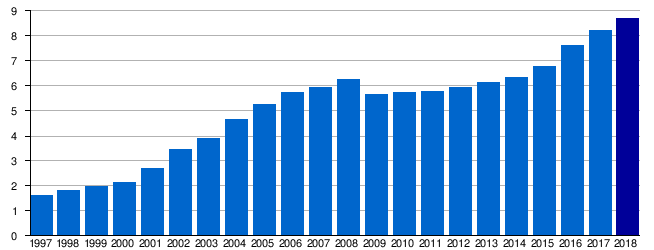 | |
| 1998 | 1,838,219 | 61,582 | ||
| 1999 | 1,993,331 | 62,072 | ||
| 2000 | 2,141,525 | 63,252 | ||
| 2001 | 2,694,464 | 69,854 | ||
| 2002 | 3,445,945 | 72,152 | ||
| 2003 | 3,915,072 | 74,635 | ||
| 2004 | 4,647,266 | 77,956 | ||
| 2005 | 5,253,752 | 84,289 | ||
| 2006 | 5,757,963 | 84,583 | ||
| 2007 | 5,926,774 | 76,428 | ||
| 2008 | 6,267,114 | 76,517 | ||
| 2009 | 5,642,921 | 70,245 | ||
| 2010 | 5,747,604 | 69,134 | ||
| 2011 | 5,780,746 | 66,179 | ||
| 2012 | 5,921,530 | 61,206 | ||
| 2013 | 6,131,896 | 65,299 | ||
| 2014 | 6,339,805 | 64,230 | ||
| 2015 | 6,786,790 | 68,074 | ||
| 2016 | 7,610,780 | 73,536 | ||
| 2017 | 8,239,250 | 76,199 | ||
| 2018 | 8,699,529 | 72,927 | ||
| Source: UK Civil Aviation Authority[88] | ||||
Busiest routes
| Rank | Airport | Total passengers | Change 2017 / 18 |
|---|---|---|---|
| 1 | 433,802 | ||
| 2 | 429,127 | ||
| 3 | 400,014 | ||
| 4 | 353,430 | ||
| 5 | 348,325 | ||
| 6 | 340,061 | ||
| 7 | 312,051 | ||
| 8 | 299,906 | ||
| 9 | 258,128 | ||
| 10 | 220,956 | ||
| 11 | 201,858 | ||
| 12 | 201,233 | ||
| 13 | 189,534 | ||
| 14 | 165,759 | ||
| 15 | 157,044 | ||
| 16 | 154,657 | ||
| 17 | 128,506 | ||
| 18 | 113,402 | ||
| 19 | 110,243 | ||
| 20 | 105,874 |
Runway
Bristol Airport has one runway designated 09/27. As the prevailing wind is from the southwest, runway 27 (the westerly direction) is used about 70% of the time. The airport has one of the shortest international airport runways in the country at just 2,060 m (6,760 ft) in length, with runway 27 having an available landing distance of only 2,060 m (6,760 ft). Despite the short runway length, the airfield is able to accommodate aircraft as large as the Boeing 787 Dreamliner and Airbus A330.[36]
Ground transport
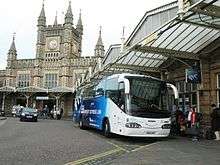
Bristol Airport is located on the A38, 8 mi (13 km) southwest of Bristol city centre. The airport is signposted from the M5 motorway, from junction 22 when approaching from the south and junction 18 when approaching from the north. Neither gives quick access to the airport, a fact which was recognised by the Greater Bristol Strategic Transport Study.[36] In November 2013, Bristol and North Somerset councils approved a planning application for the South Bristol Link Road,[90] which provides a link from the A38 northwards to the A370 at Long Ashton, giving the airport an improved connection to the M5, and a link from the A38 southwards to Hengrove Park, connecting to the Bristol Ring Road.[91] The South Bristol Link, part of the MetroBus rapid transit route,[92] was opened in January 2017 and is expected to provide a reduction in journey times to the airport for both bus passengers and car drivers.[93]
The Bristol Airport Flyer bus service links the airport to Bristol Temple Meads railway station and Bristol bus station.[94] The service, numbered A1, is operated by First West of England on behalf of Bristol Airport.[95] The same company operates the A2 service from/to Weston-super-Mare, and the A3 on a more direct route to/from Weston-super-Mare railway station. The A4 'Air Decker' service operated by Bath Bus Company links the airport with southern suburbs of Bristol, Keynsham and Bath.[96] The 'South West Falcon' service operated by Stagecoach South West runs between Bristol and Plymouth, via the airport and Bridgwater, Taunton and Exeter.[97]
Proposed rail link
In July 2016, the airport's chief executive officer Robert Sinclair discussed the possibility of a rail link to the airport.[98] The West of England LEP subsequently announced their application to the Department for Transport's Large Local Major Transport Schemes fund for the "South West Bristol Economic Link" – a strategy designed to address "poor connectivity between North Somerset, Bristol Airport and Bristol", which includes new road links as well as light or heavy rail opportunities.[99] By 2019, this proposal had been expanded as a mass transit line with potential for underground sections.
General aviation
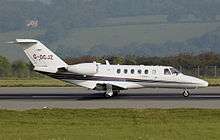
Bristol Airport is a general aviation (GA) centre. In 2006, the GA terminal was relocated from the north side next to the control tower to a purpose-built facility on the south east corner of the field. Handling for visiting executive GA aircraft is managed by Bristol Flying Centre, which also provides engineering services and operates a fleet of business jets trading as Centreline Air Charter. Handling for light GA aircraft is managed by the Bristol and Wessex Aeroplane Club.
In 2012, Bristol Flying Centre doubled the size of its terminal,[100] to 6,500 sq ft (600 m2), with self-contained security facilities and two new passenger lounges.[101] Following the closure of Bristol Filton Airport at the end of 2012, Bristol Flying Centre gained fixed-base operator traffic such as the corporate shuttle for Airbus, flying to Toulouse, and the shuttle for BAE Systems.[102] In July 2013, the Department for Transport gave approval for Bristol Flying Centre to handle charter flights directly, without needing to clear through the main airport terminal.[102]
In 2014, a new building called The Bristol Flying School was constructed to re-house the Bristol & Wessex Aeroplane Club and to contain a flying school operated by Aeros Flight Training, which formerly operated at Filton Airport.[103]
Accidents and incidents
On 19 January 1970, Vickers Viscount G-AMOA of Cambrian Airways was damaged beyond economic repair in a heavy landing.[104]
On 3 October 2010, a Thomson Airways Boeing 767 aircraft, registration G-OOBK, landed heavily on runway 09 in severe weather conditions, reduced visibility and turbulence. The flight number 519 was from Cancún Airport in Mexico and carried 258 passengers and 12 crew members. No injuries were reported. During approach, the commander decided to perform a manual landing as weather reported at Bristol was not consistent with that presented to them at their briefing. Both the commander and co-pilot were thrown forward during the touchdown, and this resulted in the commander pushing the control column forward, to a nose down position. The aircraft then rapidly pitched up and down, before eventually settling on the landing gear. None of the pilots had recent or regular experience of landings on runway 09, and they only operated to Bristol Airport approximately twice a year.[105]
On 22 December 2017, a BMI Regional Embraer ERJ145 aircraft, registration G-CKAG, exited the runway and became grounded after landing at 11:35. The flight was from Frankfurt and was carrying 22 passengers and three crew. No injuries were reported. The parking brake had been applied instead of the speed brakes before landing. The aircraft touched down on runway 27, the crew lost control of the aircraft and the aircraft exited the runway and entered a grass zone to the left, crossing taxiway Hotel at speed, causing the main landing gear tyres to burst. The aircraft came to rest in the grass shortly after. The aircraft was towed to the gate some 14 hours later. The incident resulted in several flights being diverted to other airports on what was called "Frantic Friday" as holidaymakers and families travelled for the Christmas period.[106]
Notes
- Number of passengers including domestic, international and transit.
- Number of movements represents total takeoffs and landings during that year.
References
- "NATS - AIS - Home". ead-it.com. Archived from the original on 12 March 2012. Retrieved 21 August 2019.
- "Airport data: Table 01: Size of UK airports" (PDF). UK Civil Aviation Authority. December 2018. Archived (PDF) from the original on 23 February 2019. Retrieved 22 February 2019.
- "History of Bristol Airport". Bristol Airport. Archived from the original on 28 September 2015. Retrieved 26 October 2015.
- "New vision unveiled ten years on from terminal opening". Bristol Airport. 12 March 2010. Archived from the original on 4 November 2013. Retrieved 27 August 2012.
- "CAA Passenger Survey Report 2015" (PDF). Civil Aviation Authority. Archived from the original (PDF) on 22 September 2015. Retrieved 21 August 2018.
- "The History of Bristol Airport". The Airport Guides. Archived from the original on 6 June 2012. Retrieved 10 December 2007.
- Wakefield, Kenneth (1997). "Somewhere in the West Country": The History of Bristol (Whitchurch) Airport, 1930–1957. Wilmslow: Crécy. pp. 1–2. ISBN 0-947554-65-3.
- Wakefield (1997), pp. 82–83.
- Wakefield (1997), pp. 91–93.
- Berryman, David (2006). Somerset airfields in the Second World War. Newbury: Countryside Books. pp. 87–104. ISBN 1-85306-864-0.
- "Civil Bombing Decoy C1I". PastScape. English Heritage. Archived from the original on 18 May 2015. Retrieved 12 August 2013.
- James, Ian (1989). The Story of RAF Lulsgate Bottom. Bristol: Redcliffe Press. pp. 13–14. ISBN 0-948265-48-5.
- Penny, John (2002). Bristol at War. Derby: Breedon Books. pp. 122–136. ISBN 1-85983-294-6.
- Penny (2002), p. 154.
- "Lulsgate — Bristol Airport". Chew76. Archived from the original on 30 June 2009. Retrieved 18 July 2008.
- James (1989), pp. 22–23.
- James (1989), p. 28.
- James (1989), pp. 30–31.
- James (1989), p. 34.
- Wakefield (1997), p. 112.
- James (1989), p. 39.
- James (1989), pp. 44–45.
- Wakefield (1997), p. 147.
- "New Municipal Airport For Bristol". The Times. London. 23 June 1955. p. 5.
- "Bristol To Seek B.E.A. Service". The Times. London. 1 October 1958. p. 3.
- "News in Brief". The Times. London. 16 April 1957. p. 6.
- "Court Circular". The Times. London. 2 May 1957. p. 12.
- "Picture Gallery". The Times. London. 19 September 1962. p. 6.
- Elliott, Harvey (8 July 1992). "Take-off towards new success". The Times. London. p. 27.
- "Leslie Wilson". The Times. London. 4 December 1995. p. 21.
- Belsey, James (30 November 1995). "Obituary: Les Wilson". The Independent. London: Independent News and Media. Archived from the original on 7 November 2012. Retrieved 7 April 2010.
- Reed, Arthur; Seton, Craig (28 September 1983). "Hopes fly high as the big boys pull out". The Times. London.
- "Bristol". The Times. London. 11 July 1984. p. 16.
- Elliott, Harvey (15 December 1986). "13 airports opt for first step to privatization". The Times. London. p. 2.
- "12 local authority airports begin operating as limited companies". The Financial Times. London. 1 April 1987. p. 6.
- "Bristol International Airport Master Plan 2006 to 2030". Bristol Airport. Archived from the original on 5 September 2015. Retrieved 26 October 2015.
- "Bus company in airport deal". BBC News. 11 November 1997. Retrieved 15 August 2013.
- Adburgham, Roland (6 June 1997). "Survey - Bristol 97: Sell off, then take off". The Financial Times. London.
- "Airport's terminal is in use". Bristol Evening Post. Bristol. 7 March 2000. p. 3.
- Gow, David (21 December 2000). "Over and out. FirstGroup sells Bristol airport". The Guardian. Archived from the original on 8 May 2014. Retrieved 6 May 2013.
- "Ferrovial Sells Bristol Airport Stake to Macquarie". Reuters. 1 December 2006. Archived from the original on 4 October 2012. Retrieved 6 May 2013.
- "Ontario Teachers becomes sole owner of Bristol Airport". Reuters. Archived from the original on 10 December 2017. Retrieved 9 December 2017.
- "Go-fly 10 years on: What happened to the routes and people behind Europe's then third biggest LCC?". anna.aero. 2 May 2012. Archived from the original on 30 August 2014. Retrieved 28 August 2013.
- "easyJet's dominance at Bristol under threat from Ryanair". anna.aero. 23 November 2007. Archived from the original on 4 March 2016. Retrieved 28 August 2013.
- "Continental Airlines to scrap flights to New York from Bristol". Bristol Evening Post. 6 April 2010. Archived from the original on 9 April 2010.
- "Report No: 1/2009". Air Accidents Investigation Branch. 9 January 2009. Archived from the original on 30 January 2009. Retrieved 9 January 2009.
- "Bristol airport reopens after runway repairs". The Guardian. 8 January 2007. Archived from the original on 31 August 2013. Retrieved 9 May 2013.
- "Report finds runway 'was unsafe'". BBC News. 9 January 2009. Archived from the original on 16 January 2009. Retrieved 9 January 2009.
- "Ryanair announces new city routes". BBC News. 24 May 2007. Archived from the original on 20 August 2007. Retrieved 28 August 2013.
- "Rebranded Bristol Airport drops the International". Bristol Evening Post. 12 March 2010. Archived from the original on 15 March 2010. Retrieved 12 March 2010.
- "New walkway will enhance passenger experience". Bristol Airport. 28 May 2010. Archived from the original on 14 July 2014. Retrieved 27 August 2012.
- "Airport's £6.5m project to ease passenger congestion". Bristol Post. 4 October 2013. Archived from the original on 11 October 2013. Retrieved 10 October 2013.
- Buckland, Robert (2 April 2013). "Frankfurt flights launched from Bristol Airport". Bath Business News. Archived from the original on 4 November 2013. Retrieved 2 November 2013.
- Rivers, Martin (3 September 2013). "One to one: CEO, BMI Regional". AFM Airline Fleet Management. Aviation Media. Archived from the original on 4 November 2013. Retrieved 2 November 2013.
- "Australian owners sell 50 per cent stake in Bristol Airport for £250 million". Bristol Post. 17 September 2014. Archived from the original on 19 September 2014. Retrieved 17 September 2014.
- "Airport expansion plans grounded". BBC News. 20 October 2007. Archived from the original on 6 June 2012. Retrieved 23 October 2007.
- "Airport CO2 rivals African nation". BBC News. 11 October 2007. Archived from the original on 13 October 2007. Retrieved 23 October 2007.
- "Airport expansion plans take-off". BBC News. 26 October 2005. Archived from the original on 13 September 2007. Retrieved 5 April 2014.
- "Airport's plans go before council". BBC News. 16 June 2009. Retrieved 5 April 2014.
- "Bristol Airport expansion over 'final hurdle'". BBC News. 17 September 2010. Archived from the original on 25 September 2015. Retrieved 5 April 2014.
- "Bristol Airport expansion approval 'was legal'". BBC News. 26 October 2011. Archived from the original on 17 August 2014. Retrieved 4 May 2013.
- "Bristol Airport expansion: Pool of contractors appointed". BBC News. 10 January 2013. Archived from the original on 17 August 2014. Retrieved 4 May 2013.
- "Our future". Bristol Airport. Archived from the original on 21 October 2015. Retrieved 26 October 2015.
- Wright, Tom (27 June 2012). "First phase of airport expansion opens". The Weston & Somerset Mercury. Archived from the original on 7 April 2014. Retrieved 4 May 2013.
- "Bristol Airport announces best ever figures for June". Bristol Post. 21 July 2014. Archived from the original on 26 July 2014. Retrieved 22 July 2014.
- "New Bristol Airport terminal opens for business". Bristol Post. 3 July 2015. Archived from the original on 7 July 2015. Retrieved 8 July 2015.
- Ribbeck, M. (29 June 2016). "Could the problems of long queues at Bristol Airport finally be solved?". Bristol Post. Archived from the original on 5 September 2016. Retrieved 1 November 2016.
- "Passport Control". Bristol Airport. Archived from the original on 27 September 2016. Retrieved 9 December 2017.
- "Bristol Airport hotel plan approved by councillors". BBC News. 14 October 2010. Archived from the original on 17 October 2010. Retrieved 1 November 2010.
- Wright, Tom (28 February 2014). "Plans for new hotel made public". The Weston & Somerset Mercury. Archived from the original on 7 April 2014. Retrieved 22 March 2014.
- "First hotel to be built at Bristol Airport will be Hampton by Hilton". Bristol Post. 2 February 2015. Archived from the original on 5 February 2015. Retrieved 5 February 2015.
- Morby, Aaron (26 November 2014). "Chinese firm to build £15m Bristol sea container hotel". Construction Enquirer. Archived from the original on 19 December 2014. Retrieved 6 February 2015.
- "Work Begins on Bristol Airport's First Multi-Storey Car Park". Bristol Airport. 13 November 2017. Retrieved 30 May 2018.
- "Plan to expand Bristol airport rejected after climate protests". The Guardian. 11 February 2020. Retrieved 5 March 2020.
- "Where can I fly?". Bristol Airport. Archived from the original on 21 October 2015.
- https://www.balkanholidays.co.uk/flight_only/timetable/index.html?edition=W20&flight_from=&flight_to=&month=
- https://www.blueislands.com/flying-with-us/schedule-update-05-march-2020
- Liu, Jim. "easyJet schedules new routes in W19". Routesonline. Archived from the original on 16 July 2019. Retrieved 16 July 2019.
- "New routes from the UK - easyJet". www.easyjet.com. Archived from the original on 12 July 2018. Retrieved 18 July 2018.
- https://www.easyjet.com/en/book/our-new-routes
- https://www.easyjet.com/en/book/our-new-routes
- "Flybmi update - 17th February - Loganair". www.loganair.co.uk. Archived from the original on 18 February 2019. Retrieved 17 February 2019.
- "Austrian airline Lauda has launched new cheap flights at Bristol Airport". bristolpost.co.uk. 26 September 2019.
- Liu, Jim. "Ryanair / Laudamotion S20 network consolidation as of 18JUN20". Routesonline. Retrieved 19 June 2020.
- "Flight Timetable". tui.co.uk.
- Liu, Jim (19 November 2019). "TUI Airways resumes Sharm el Sheikh service from Feb 2020". routesonline.com.
- "TUI announces new flight route to Enfidha from Bristol Airport for summer 2020". bristolpost.co.uk. 8 May 2019. Retrieved 26 May 2019.
- "UK airport data". Civil Aviation Authority. Archived from the original on 23 February 2019. Retrieved 22 February 2019.
- "Airport Data 2018". UK Civil Aviation Authority. 3 March 2018. Tables 12.1(XLS) and 12.2 (XLS). Archived from the original on 3 March 2019. Retrieved 5 March 2019.
- "South Bristol link road: Bristol City Council gives approval". BBC News. 27 November 2013. Archived from the original on 29 November 2013. Retrieved 27 November 2013.
- "£45m link road scheme - planning documents reveal details". North Somerset Times. 29 July 2013. Archived from the original on 4 October 2013. Retrieved 1 September 2013.
- "South Bristol Link". Travelwest. Archived from the original on 20 June 2016. Retrieved 22 April 2016.
- "Special report: What the South Bristol Link road will do for business". South West Business. 31 March 2016. Archived from the original on 9 May 2016.
- "More buses and quicker journey on Bristol airport route". Bristol Post. 22 August 2013. Archived from the original on 27 August 2013. Retrieved 31 August 2013.
- "Bristol Flyer". Bristol Airport. Archived from the original on 1 October 2017. Retrieved 2 October 2017.
- "Air Decker". Bath Bus Company. Archived from the original on 16 March 2018. Retrieved 11 April 2018.
- "SW Falcon: From Plymouth to Bristol & back again 24/7". Stagecoach. Archived from the original on 3 February 2016. Retrieved 11 April 2018.
- "Archived copy". Archived from the original on 5 October 2016. Retrieved 6 October 2016.CS1 maint: archived copy as title (link)
- "Transport investment". westofenglandlep.co.uk. Archived from the original on 9 October 2016. Retrieved 6 October 2016.
- "Bristol Flying Centre new FBO open for business". Eva International news. 14 March 2013. Archived from the original on 5 March 2016. Retrieved 4 August 2013.
- Epstein, Curt (1 January 2013). "Bristol Flying Center Set for Expansion". Aviation International News. Archived from the original on 28 May 2013. Retrieved 4 August 2013.
- Sarsfield, Kate (25 July 2013). "Bristol airport sets sights on becoming major UK business aviation hub". flightglobal.com. Archived from the original on 28 July 2013. Retrieved 4 August 2013.
- Ribbeck, Michael (16 October 2014). "Flying school comes in to land at new headquarters". Bristol Post. Archived from the original on 6 December 2014. Retrieved 13 December 2014.
- "Accident description". Aviation Safety Network. Archived from the original on 25 October 2012. Retrieved 8 October 2009.
- "Boeing 767-324, G-OOBK, 3 October 2010". GOV.UK. Archived from the original on 10 May 2019. Retrieved 10 May 2019.
- "Plane comes off runway after landing". BBC News: Bristol. 22 December 2017. Archived from the original on 23 December 2017. Retrieved 23 December 2017.
External links
![]()